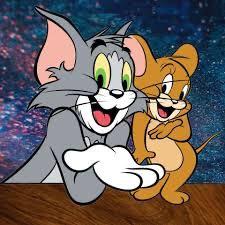Rediscovering Tom And Jerry Through A Quantum Lens
Albert Einstein, Boris Podolsky and Nathan Rosen would be rolling in their respective graves if they knew that their revolutionary entanglement theory was being compared to the popular cartoon Tom and Jerry.
This beloved feline-and-rodent duo has entertained generations of viewers with non-stop chase and slapstick humour. Prima facie, this classic cartoon may seem light years apart from the complex and enigmatic realm of quantum theory. However, on a closer look, one can trace the quantum-like aspects concealed within an animated world of mayhem.
It may be a rewarding exercise to peek into the world of Tom and Jerry through the curious lens of quantum physics. Entanglement is one of the most perplexing phenomena in the realm of quantum mechanics, which challenges classical intuitions. At its core, entanglement refers to a quantum state in which the properties of two or more particles become intertwined in such a way that the measurement of one particle instantaneously determines the state of another, regardless of the spatial separation between them.
In the cartoon world of Tom and Jerry, their destiny is similarly entangled. Their existence is intertwined in a perpetual chase where the action of one impacts that of the other almost immediately. This entanglement is reminiscent of quantum particles that share a mysterious connection, regardless of the space between them.
The observer effect is a phenomenon where the behaviour of observed particles is modified by the very act of observation. This phenomenon stems from the wave-like characteristics of matter, allowing particles to exist in multiple states simultaneously.
When observers conduct measurement on a particle’s specific property, they effectively collapse the particle’s wave function, compelling it to adopt a distinct state. It serves as a reminder that the quantum world is inherently different from the classical world, introducing a level of unpredictability and subjectivity that challenges our traditional notions of reality and observation.
Similarly, the audience’s perspective and reactions to Tom and Jerry can influence their perception of the characters and the humour. The viewer’s perspective can shift, making them empathise with either the cat or the mouse, altering their interpretation of the chase’s dynamics. One revolutionary feat in modern physics is the double-slit experiment, which demonstrates the intriguing wave-particle duality of quantum particles, their ability to create interference patterns even when sent one at a time, and the role of observation in collapsing their wave functions and determining their behaviour.
This experiment underscores the fundamental and mysterious nature of quantum mechanics. Viewers of this cartoon would agree that Tom and Jerry, too, demonstrate a form of duality in their characters.
Tom, the seemingly tyrannical and menacing cat, can sometimes assume a more sympathetic or even endearing role. Likewise, Jerry, the innocent-looking, cute mouse, can become quite cunning and strategic. Just as particles can shift between different states, these characters oscillate between their roles, showing that appearances can be deceiving.
The unpredictable cat-and-mouse chase can find quantum counterparts in Heisenberg’s Uncertainty Principle, which states that it is impossible to simultaneously know the exact position and momentum of a particle with absolute precision. In Tom and Jerry, we find a similar sense of uncertainty.
The cat, Tom, and the mouse, Jerry, are in a constant state of unpredictability. No matter how meticulously Tom plans his strategies or Jerry concocts his escapes, the outcome remains uncertain. Just like particles in quantum physics, their positions and trajectories are constantly changing, making it impossible for one to predict the other’s next move with certainty.
In the quantum world, particles can exist in multiple states or positions simultaneously, known as superposition, where particles can exist in multiple states at once until observed. Within the cartoon’s context, Tom and Jerry often find themselves in a superposition of states. In many episodes, Tom and Jerry exist in multiple realities simultaneously.
Tom can be both the predator and the prey, and Jerry can be both the escape artist and the troublemaker. This resonates with the concept of quantum superposition.
However weird or bizarre it may seem, Tom and Jerry and quantum theory serve as a reminder that even in the most unexpected places, we can find glimpses of the complex and enigmatic nature of the universe.
So, the next time you watch Tom and Jerry’s timeless antics, remember that beneath the laughter and mayhem, there may be a hint of quantum physics at play. Mr Einstein, did I hear you chuckle from a parallel universe?


Comments are closed.